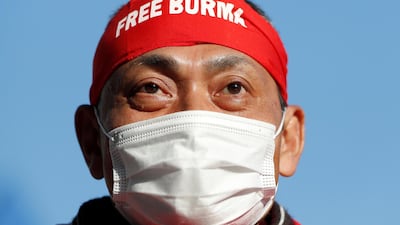The United States says it supports a peaceful, prosperous, and democratic Burma; the British government, until recently, would as well. While in Australia, officials may be heard to talk about activities in Burma or Myanmar, depending on the day.
Other times, you will also hear or read the phrase, “Myanmar, also known as Burma”.
So, what is the country called, why is there debate and what is the “correct” name?
Where did the name come from?
The word Burma comes from the name of the country’s largest ethnic group and has been in use for hundreds of years, with inscriptions dating back to the 1100s.
It might not be obvious to the ear of an English speaker, but Burmah – as it was previously spelt – is a corruption of the pronunciation of Myanmar, and in the Burmese language there is a sharp difference between spoken and written forms. Those early inscriptions were essentially spelt Myanmar.
The British – who colonised and ruled Myanmar for more than 100 years, from 1824 to 1948 – called it British Burma and on independence, it became the Union of Burma.
But, in 1989, the military ruling junta decided to change the official name from Burma to Myanmar, after a review of colonial-era names used for the country, cities – Rangoon became Yangon – and province titles.
Why did the name change and what was the controversy?
The military rulers said that the new name was more inclusive of the country’s minorities, while opponents said it was just a more formally written version of the same thing.
Human rights groups have also argued that the new name is in fact more anti-minority, as the military enforcing the name change has persecuted minorities, including being accused of genocidal intent for the 2017 crackdowns in Rakhine State.
In the media, many outlets kept using Burma for some time.
The general approach is to use the title that most readers or listeners will know and understand. Over the years, many have slowly changed to putting Myanmar above Burma as the change became more commonly known. But most will still put the clarifier "also known as Burma" after the first reference.
But while the change was recognised by the UN, France and many other nations, it was not by the UK or US.
Why? Politics, mostly.
-

Myanmar nationals in Japan demonstrate against the military coup that took place in their home country on Monday, February 1, 2021. Getty Images -

A Myanmar national in Japan holds up a portrait of Aung San Suu Kyi during a protest held in front of the United Nations University in Tokyo. EPA -

People hold up images of Myanmar's de-facto leader Aung San Suu Kyi at a protest outside Maynmar's embassy in Bangkok, Thailand. Getty Images -

NLD supporters shout slogans outside Myanmar's embassy during a rally after the military seized power from a democratically elected civilian government and arrested its leader Aung San Suu Kyi, in Bangkok, Thailand. Reuters -
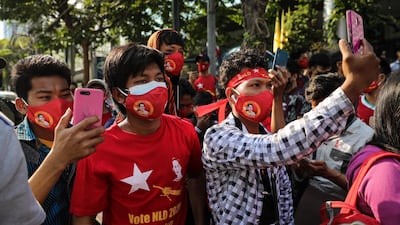
People use their smartphones to live stream a protest outside Myanmar's embassy in Bangkok, Thailand. Getty Images -
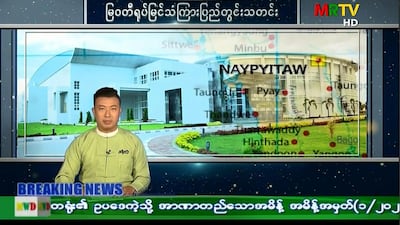
This screengrab provided via AFPTV and taken from a broadcast by Myanmar Radio and Television (MRTV) in Myanmar shows the announcement of a one-year state of emergency in the country. AFP -
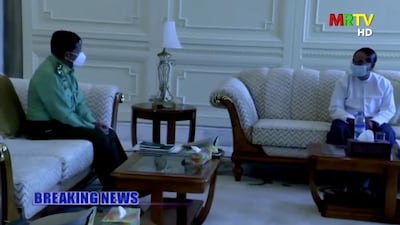
A screen grab from Myanmar state television footage shows Myanmar Acting President Myint Swe (R) and General Min Aung Hlaing (L) as they attend a meeting. Reuters -

A military helicopter flies in Naypyitaw, Myanmar. EPA -

Cars pass police sitting in trucks along a road in Yangon, as Myanmar's military detained the country's de facto leader Aung San Suu Kyi and the country's president in a coup. AFP -

Policemen sit inside trucks parked on a road in the downtown area of Yangon, Myanmar. AP -

Myanmar military supporters riding a vehicle wave a military flag as they go around Yangon, Myanmar. AP -

People wave flags as they ride on a vehicle in Yangon, Myanmar. Reuters -

A view of Shwedagon Pagoda, a Buddhist religious landmark in Yangon, as Myanmar's military detained the country's de facto leader Aung San Suu Kyi and the country's president in a coup. AFP -
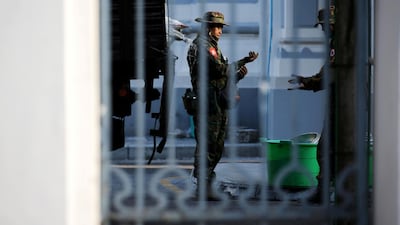
Myanmar soldiers are seen inside City Hall in Yangon, Myanmar. Reuters -

A woman leaves her house while being escorted by soldiers (unseen) at an unidentified location in Myanmar, in this picture obtained from social media. Reuters -
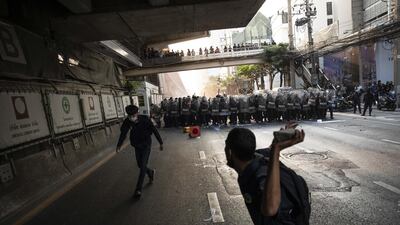
A demonstrator prepares to throw a rock towards riot police during a protest outside the Embassy of Myanmar in Bangkok, Thailand. Andre Malerba/Bloomberg -
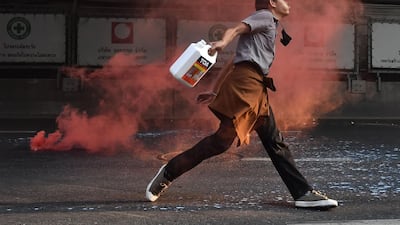
A Thai pro-democracy protestor confronts riot police in Bangkok, in the area where Myanmar migrants were demonstrating after Myanmar's military detained the country's de facto leader Aung San Suu Kyi and the country's president in a coup. AFP -
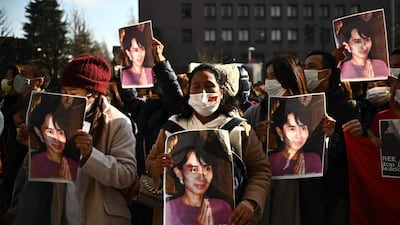
A group of Myanmar activists hold the portrait of Aung San Suu Kyi during a protest outside the United Nation university in Tokyo following a military coup in the country by a general after arresting civilian leader Aung San Suu Kyi and other senior officials. AFP -

Anti-Thai government protester wields a traffic cone at riot police during a clash at a rally for Myanmar's democracy outside the embassy, in Bangkok, Thailand. Reuters
Why some countries still use Burma
The isolated Myanmar military junta was no friend to either the US or the UK governments, who both urged a transfer to civilian rule. The political background to the change, therefore, influenced policies towards the naming convention.
Mark Farmaner, of Burma Campaign UK, a human rights non-government organisation, told the BBC in 2011: "Often you can tell where someone's sympathies lie if they use Burma or Myanmar. Myanmar is a kind of indicator of countries that are soft on the regime."
But, he said, the issue over the name was not nearly as important as how the country treats minorities, human rights and freedoms.
Changing attitudes
As the country began to move towards democratic transition after 2008, this posed an issue for the likes of the US.
When, in 2011, Hillary Clinton, secretary of state at the time, became the first person in the post to visit since 1955, what was she to call the country? Officials said that she saw it as an "unhappy choice" – offend her hosts or upend years of US policy?
Her solution? She said Burma – sparingly – but mostly avoided any name, instead using phrases like "this country" wherever possible.
But with the democratic reforms from 2011, more countries started referring to Myanmar more often.
The British government cited the elected National League for Democracy government’s preference for their style change.
When Aung San Suu Kyi took charge as State Counsellor of Myanmar in 2016, she tried to settle the naming issue.
Foreigners, she said, were free to use either, as there was no specific term listed as the official name of the country in the constitution.
57%20Seconds
Abu Dhabi World Pro 2019 remaining schedule:
Wednesday April 24: Abu Dhabi World Professional Jiu-Jitsu Championship, 11am-6pm
Thursday April 25: Abu Dhabi World Professional Jiu-Jitsu Championship, 11am-5pm
Friday April 26: Finals, 3-6pm
Saturday April 27: Awards ceremony, 4pm and 8pm
COMPANY PROFILE
John%20Wick%3A%20Chapter%204
How does ToTok work?
The calling app is available to download on Google Play and Apple App Store
To successfully install ToTok, users are asked to enter their phone number and then create a nickname.
The app then gives users the option add their existing phone contacts, allowing them to immediately contact people also using the application by video or voice call or via message.
Users can also invite other contacts to download ToTok to allow them to make contact through the app.
Results:
5pm: Conditions (PA) Dh80,000 1,400m | Winner: AF Tahoonah, Richard Mullen (jockey), Ernst Oertel (trainer)
5.30pm: Handicap (TB) Dh90,000 1,400m | Winner: Ajwad, Gerald Avranche, Rashed Bouresly
6pm: Maiden (PA) Dh80,000 1,600m | Winner: RB Lam Tara, Fabrice Veron, Eric Lemartinel
6.30pm: Handicap (PA) Dh80,000 1,600m | Winner: Duc De Faust, Szczepan Mazur, Younis Al Kalbani
7pm: Wathba Stallions Cup (PA) Dh70,000 2,200m | Winner: Shareef KB, Fabrice Veron, Ernst Oertel
7.30pm: Handicap (PA) Dh90,000 1,500m | Winner: Bainoona, Pat Cosgrave, Eric Lemartinel
While you're here
MORE FROM ED HUSAIN: The UAE-Israel accord is a win for every Muslim
The%C2%A0specs%20
Fighting with My Family
Director: Stephen Merchant
Stars: Dwayne Johnson, Nick Frost, Lena Headey, Florence Pugh, Thomas Whilley, Tori Ellen Ross, Jack Lowden, Olivia Bernstone, Elroy Powell
Four stars
DC%20League%20of%20Super-Pets
Tiger%20Stripes%20
EXPATS
The specs
Engine: 1.5-litre turbo
Power: 181hp
Torque: 230Nm
Transmission: 6-speed automatic
Starting price: Dh79,000
On sale: Now
While you're here
Gavin Esler: The Good Friday Agreement teaches us some important lessons
Damien McElroy: Boris must listen to Churchill's comments on Irish divisions
Janine di Giovanni: Track 2 diplomacy key to lasting peace in 21st century
UPI facts
More than 2.2 million Indian tourists arrived in UAE in 2023
More than 3.5 million Indians reside in UAE
Indian tourists can make purchases in UAE using rupee accounts in India through QR-code-based UPI real-time payment systems
Indian residents in UAE can use their non-resident NRO and NRE accounts held in Indian banks linked to a UAE mobile number for UPI transactions
In 2018, the ICRC received 27,756 trace requests in the Middle East alone. The global total was 45,507.
There are 139,018 global trace requests that have not been resolved yet, 55,672 of these are in the Middle East region.
More than 540,000 individuals approached the ICRC in the Middle East asking to be reunited with missing loved ones in 2018.
The total figure for the entire world was 654,000 in 2018.
All you need to know about Formula E in Saudi Arabia
What The Saudia Ad Diriyah E-Prix
When Saturday
Where Diriyah in Saudi Arabia
What time Qualifying takes place from 11.50am UAE time through until the Super Pole session, which is due to end at 12.55pm. The race, which will last for 45 minutes, starts at 4.05pm.
Who is competing There are 22 drivers, from 11 teams, on the grid, with each vehicle run solely on electronic power.
Women%E2%80%99s%20T20%20World%20Cup%20Qualifier
The%20Genius%20of%20Their%20Age
BRAZIL%20SQUAD
JERSEY INFO
Red Jersey
General Classification: worn daily, starting from Stage 2, by the leader of the General Classification by time.
Green Jersey
Points Classification: worn daily, starting from Stage 2, by the fastest sprinter, who has obtained the best positions in each stage and intermediate sprints.
White Jersey
Young Rider Classification: worn daily, starting from Stage 2, by the best young rider born after January 1, 1995 in the overall classification by time (U25).
Black Jersey
Intermediate Sprint Classification: worn daily, starting from Stage 2, by the rider who has gained the most Intermediate Sprint Points.
Where to donate in the UAE
You can donate to several registered charities through a “donation catalogue”. The use of the donation is quite specific, such as buying a fan for a poor family in Niger for Dh130.
The General Authority of Islamic Affairs & Endowments
The site has an e-donation service accepting debit card, credit card or e-Dirham, an electronic payment tool developed by the Ministry of Finance and First Abu Dhabi Bank.
You can donate online or order Smiles n’ Stuff products handcrafted by Al Noor students. The centre publishes a wish list of extras needed, starting at Dh500.
Beit Al Khair Society has the motto “From – and to – the UAE,” with donations going towards the neediest in the country. Its website has a list of physical donation sites, but people can also contribute money by SMS, bank transfer and through the hotline 800-22554.
Dar Al Ber Society, which has charity projects in 39 countries, accept cash payments, money transfers or SMS donations. Its donation hotline is 800-79.
Dubai Cares provides several options for individuals and companies to donate, including online, through banks, at retail outlets, via phone and by purchasing Dubai Cares branded merchandise. It is currently running a campaign called Bookings 2030, which allows people to help change the future of six underprivileged children and young people.
Those who travel on Emirates have undoubtedly seen the little donation envelopes in the seat pockets. But the foundation also accepts donations online and in the form of Skywards Miles. Donated miles are used to sponsor travel for doctors, surgeons, engineers and other professionals volunteering on humanitarian missions around the world.
On the Emirates Red Crescent website you can choose between 35 different purposes for your donation, such as providing food for fasters, supporting debtors and contributing to a refugee women fund. It also has a list of bank accounts for each donation type.
Gulf for Good raises funds for partner charity projects through challenges, like climbing Kilimanjaro and cycling through Thailand. This year’s projects are in partnership with Street Child Nepal, Larchfield Kids, the Foundation for African Empowerment and SOS Children's Villages. Since 2001, the organisation has raised more than $3.5 million (Dh12.8m) in support of over 50 children’s charities.
Sheikh Mohammed bin Rashid Al Maktoum launched the Noor Dubai Foundation a decade ago with the aim of eliminating all forms of preventable blindness globally. You can donate Dh50 to support mobile eye camps by texting the word “Noor” to 4565 (Etisalat) or 4849 (du).
The Greatest Royal Rumble card
50-man Royal Rumble - names entered so far include Braun Strowman, Daniel Bryan, Kurt Angle, Big Show, Kane, Chris Jericho, The New Day and Elias
Universal Championship Brock Lesnar (champion) v Roman Reigns in a steel cage match
WWE World Heavyweight ChampionshipAJ Styles (champion) v Shinsuke Nakamura
Intercontinental Championship Seth Rollins (champion) v The Miz v Finn Balor v Samoa Joe
United States Championship Jeff Hardy (champion) v Jinder Mahal
SmackDown Tag Team Championship The Bludgeon Brothers (champions) v The Usos
Raw Tag Team Championship (currently vacant) Cesaro and Sheamus v Matt Hardy and Bray Wyatt
Casket match The Undertaker v Rusev
Singles match John Cena v Triple H
Cruiserweight Championship Cedric Alexander v Kalisto
You might also like
Mercer, the investment consulting arm of US services company Marsh & McLennan, expects its wealth division to at least double its assets under management (AUM) in the Middle East as wealth in the region continues to grow despite economic headwinds, a company official said.
Mercer Wealth, which globally has $160 billion in AUM, plans to boost its AUM in the region to $2-$3bn in the next 2-3 years from the present $1bn, said Yasir AbuShaban, a Dubai-based principal with Mercer Wealth.
“Within the next two to three years, we are looking at reaching $2 to $3 billion as a conservative estimate and we do see an opportunity to do so,” said Mr AbuShaban.
Mercer does not directly make investments, but allocates clients’ money they have discretion to, to professional asset managers. They also provide advice to clients.
“We have buying power. We can negotiate on their (client’s) behalf with asset managers to provide them lower fees than they otherwise would have to get on their own,” he added.
Mercer Wealth’s clients include sovereign wealth funds, family offices, and insurance companies among others.
From its office in Dubai, Mercer also looks after Africa, India and Turkey, where they also see opportunity for growth.
Wealth creation in Middle East and Africa (MEA) grew 8.5 per cent to $8.1 trillion last year from $7.5tn in 2015, higher than last year’s global average of 6 per cent and the second-highest growth in a region after Asia-Pacific which grew 9.9 per cent, according to consultancy Boston Consulting Group (BCG). In the region, where wealth grew just 1.9 per cent in 2015 compared with 2014, a pickup in oil prices has helped in wealth generation.
BCG is forecasting MEA wealth will rise to $12tn by 2021, growing at an annual average of 8 per cent.
Drivers of wealth generation in the region will be split evenly between new wealth creation and growth of performance of existing assets, according to BCG.
Another general trend in the region is clients’ looking for a comprehensive approach to investing, according to Mr AbuShaban.
“Institutional investors or some of the families are seeing a slowdown in the available capital they have to invest and in that sense they are looking at optimizing the way they manage their portfolios and making sure they are not investing haphazardly and different parts of their investment are working together,” said Mr AbuShaban.
Some clients also have a higher appetite for risk, given the low interest-rate environment that does not provide enough yield for some institutional investors. These clients are keen to invest in illiquid assets, such as private equity and infrastructure.
“What we have seen is a desire for higher returns in what has been a low-return environment specifically in various fixed income or bonds,” he said.
“In this environment, we have seen a de facto increase in the risk that clients are taking in things like illiquid investments, private equity investments, infrastructure and private debt, those kind of investments were higher illiquidity results in incrementally higher returns.”
The Abu Dhabi Investment Authority, one of the largest sovereign wealth funds, said in its 2016 report that has gradually increased its exposure in direct private equity and private credit transactions, mainly in Asian markets and especially in China and India. The authority’s private equity department focused on structured equities owing to “their defensive characteristics.”
Greatest Royal Rumble results
John Cena pinned Triple H in a singles match
Cedric Alexander retained the WWE Cruiserweight title against Kalisto
Matt Hardy and Bray Wyatt win the Raw Tag Team titles against Cesaro and Sheamus
Jeff Hardy retained the United States title against Jinder Mahal
Bludgeon Brothers retain the SmackDown Tag Team titles against the Usos
Seth Rollins retains the Intercontinental title against The Miz, Finn Balor and Samoa Joe
AJ Styles remains WWE World Heavyweight champion after he and Shinsuke Nakamura are both counted out
The Undertaker beats Rusev in a casket match
Brock Lesnar retains the WWE Universal title against Roman Reigns in a steel cage match
Braun Strowman won the 50-man Royal Rumble by eliminating Big Cass last
Director: Jon Favreau
Starring: Donald Glover, Seth Rogen, John Oliver
Rating: 2 out of 5 stars
THE BIO
Favourite author - Paulo Coelho
Favourite holiday destination - Cuba
New York Times or Jordan Times? NYT is a school and JT was my practice field
Role model - My Grandfather
Dream interviewee - Che Guevara
Company profile
Name: Back to Games and Boardgame Space
Started: Back to Games (2015); Boardgame Space (Mark Azzam became co-founder in 2017)
Founder: Back to Games (Mr Azzam); Boardgame Space (Mr Azzam and Feras Al Bastaki)
Based: Dubai and Abu Dhabi
Industry: Back to Games (retail); Boardgame Space (wholesale and distribution)
Funding: Back to Games: self-funded by Mr Azzam with Dh1.3 million; Mr Azzam invested Dh250,000 in Boardgame Space
Growth: Back to Games: from 300 products in 2015 to 7,000 in 2019; Boardgame Space: from 34 games in 2017 to 3,500 in 2019
Killing of Qassem Suleimani
National Editorial: Suleimani has been killed, now we must de-escalate
Mina Al Oraibi: Air strike casts a long shadow over the decade ahead
Jack Moore: Why the assassination is such a monumental gamble
Matthew Levitt: Iran retains its ability to launch terror attacks
Damien McElroy: A CEO tasked with spreading Iran's influence
Hussein Ibish: Trump's order on solid constitutional ground
Rashmee Roshan Lall: Sound of silence in South Asia
The specs: 2018 Harley-Davidson Fat Boy
Price, base / as tested Dh97,600
Engine 1,745cc Milwaukee-Eight v-twin engine
Transmission Six-speed gearbox
Power 78hp @ 5,250rpm
Torque 145Nm @ 3,000rpm
Fuel economy, combined 5.0L / 100km (estimate)
GOLF’S RAHMBO
- 5 wins in 22 months as pro
- Three wins in past 10 starts
- 45 pro starts worldwide: 5 wins, 17 top 5s
- Ranked 551th in world on debut, now No 4 (was No 2 earlier this year)
- 5th player in last 30 years to win 3 European Tour and 2 PGA Tour titles before age 24 (Woods, Garcia, McIlroy, Spieth)
Why seagrass matters
- Carbon sink: Seagrass sequesters carbon up to 35X faster than tropical rainforests
- Marine nursery: Crucial habitat for juvenile fish, crustations, and invertebrates
- Biodiversity: Support species like sea turtles, dugongs, and seabirds
- Coastal protection: Reduce erosion and improve water quality
Infiniti QX80 specs
Engine: twin-turbocharged 3.5-liter V6
Power: 450hp
Torque: 700Nm
Price: From Dh450,000, Autograph model from Dh510,000
Available: Now
Timeline
2012-2015
The company offers payments/bribes to win key contracts in the Middle East
May 2017
The UK SFO officially opens investigation into Petrofac’s use of agents, corruption, and potential bribery to secure contracts
September 2021
Petrofac pleads guilty to seven counts of failing to prevent bribery under the UK Bribery Act
October 2021
Court fines Petrofac £77 million for bribery. Former executive receives a two-year suspended sentence
December 2024
Petrofac enters into comprehensive restructuring to strengthen the financial position of the group
May 2025
The High Court of England and Wales approves the company’s restructuring plan
July 2025
The Court of Appeal issues a judgment challenging parts of the restructuring plan
August 2025
Petrofac issues a business update to execute the restructuring and confirms it will appeal the Court of Appeal decision
October 2025
Petrofac loses a major TenneT offshore wind contract worth €13 billion. Holding company files for administration in the UK. Petrofac delisted from the London Stock Exchange
November 2025
180 Petrofac employees laid off in the UAE
Company Profile
Name: Thndr
Started: 2019
Co-founders: Ahmad Hammouda and Seif Amr
Sector: FinTech
Headquarters: Egypt
UAE base: Hub71, Abu Dhabi
Current number of staff: More than 150
Funds raised: $22 million
Dirham Stretcher tips for having a baby in the UAE
Selma Abdelhamid, the group's moderator, offers her guide to guide the cost of having a young family:
• Buy second hand stuff
They grow so fast. Don't get a second hand car seat though, unless you 100 per cent know it's not expired and hasn't been in an accident.
• Get a health card and vaccinate your child for free at government health centres
Ms Ma says she discovered this after spending thousands on vaccinations at private clinics.
• Join mum and baby coffee mornings provided by clinics, babysitting companies or nurseries.
Before joining baby classes ask for a free trial session. This way you will know if it's for you or not. You'll be surprised how great some classes are and how bad others are.
• Once baby is ready for solids, cook at home
Take the food with you in reusable pouches or jars. You'll save a fortune and you'll know exactly what you're feeding your child.
COMPANY%20PROFILE%20
While you're here
Hussein Ibish: America's attitude to Palestine and Israel has subtly shifted
Con Coughlin: With every missile fired in Israel-Gaza, Biden's clout reduces
Anwar Mhajne: The moral burden of being a Palestinian citizen of Israel
Benefits of first-time home buyers' scheme
- Priority access to new homes from participating developers
- Discounts on sales price of off-plan units
- Flexible payment plans from developers
- Mortgages with better interest rates, faster approval times and reduced fees
- DLD registration fee can be paid through banks or credit cards at zero interest rates
In-demand jobs and monthly salaries
- Technology expert in robotics and automation: Dh20,000 to Dh40,000
- Energy engineer: Dh25,000 to Dh30,000
- Production engineer: Dh30,000 to Dh40,000
- Data-driven supply chain management professional: Dh30,000 to Dh50,000
- HR leader: Dh40,000 to Dh60,000
- Engineering leader: Dh30,000 to Dh55,000
- Project manager: Dh55,000 to Dh65,000
- Senior reservoir engineer: Dh40,000 to Dh55,000
- Senior drilling engineer: Dh38,000 to Dh46,000
- Senior process engineer: Dh28,000 to Dh38,000
- Senior maintenance engineer: Dh22,000 to Dh34,000
- Field engineer: Dh6,500 to Dh7,500
- Field supervisor: Dh9,000 to Dh12,000
- Field operator: Dh5,000 to Dh7,000
Killing of Qassem Suleimani
National Editorial: Suleimani has been killed, now we must de-escalate
Mina Al Oraibi: Air strike casts a long shadow over the decade ahead
Jack Moore: Why the assassination is such a monumental gamble
Damien McElroy: A CEO tasked with spreading Iran's influence
Hussein Ibish: Trump's order on solid constitutional ground
Simon Waldman: Cautious Israel keeping a low profile
Gully Boy
Director: Zoya Akhtar
Producer: Excel Entertainment & Tiger Baby
Cast: Ranveer Singh, Alia Bhatt, Kalki Koechlin, Siddhant Chaturvedi
Rating: 4/5 stars
Forced%20Deportations
Violence%20
Results
1.30pm Handicap (PA) Dh50,000 (Dirt) 1,400m
Winner Al Suhooj, Saif Al Balushi (jockey), Khalifa Al Neyadi (trainer)
2pm Handicap (TB) 68,000 (D) 1,950m
Winner Miracle Maker, Xavier Ziani, Salem bin Ghadayer
2.30pm Maiden (TB) Dh60,000 (D) 1,600m
Winner Mazagran, Tadhg O’Shea, Satish Seemar
3pm Handicap (TB) Dh84,000 (D) 1,800m
Winner Tailor’s Row, Royston Ffrench, Salem bin Ghadayer
3.30pm Handicap (TB) Dh76,000 (D) 1,400m
Winner Alla Mahlak, Adrie de Vries, Rashed Bouresly
4pm Maiden (TB) Dh60,000 (D) 1,200m
Winner Hurry Up, Royston Ffrench, Salem bin Ghadayer
4.30pm Handicap (TB) Dh68,000 (D) 1,200m
RESULTS
6.30pm: Longines Conquest Classic Dh150,000 Maiden 1,200m.
Winner: Halima Hatun, Antonio Fresu (jockey), Ismail Mohammed (trainer).
7.05pm: Longines Gents La Grande Classique Dh155,000 Handicap 1,200m.
Winner: Moosir, Dane O’Neill, Doug Watson.
7.40pm: Longines Equestrian Collection Dh150,000 Maiden 1,600m.
Winner: Mazeed, Richard Mullen, Satish Seemar.
8.15pm: Longines Gents Master Collection Dh175,000 Handicap.
Winner: Thegreatcollection, Pat Dobbs, Doug Watson.
8.50pm: Longines Ladies Master Collection Dh225,000 Conditions 1,600m.
Winner: Cosmo Charlie, Pat Dobbs, Doug Watson.
9.25pm: Longines Ladies La Grande Classique Dh155,000 Handicap 1,600m.
Winner: Secret Trade, Tadhg O’Shea, Ali Rashid Al Raihe.
10pm: Longines Moon Phase Master Collection Dh170,000 Handicap 2,000m.
Winner:
What is a robo-adviser?
Robo-advisers use an online sign-up process to gauge an investor’s risk tolerance by feeding information such as their age, income, saving goals and investment history into an algorithm, which then assigns them an investment portfolio, ranging from more conservative to higher risk ones.
These portfolios are made up of exchange traded funds (ETFs) with exposure to indices such as US and global equities, fixed-income products like bonds, though exposure to real estate, commodity ETFs or gold is also possible.
Investing in ETFs allows robo-advisers to offer fees far lower than traditional investments, such as actively managed mutual funds bought through a bank or broker. Investors can buy ETFs directly via a brokerage, but with robo-advisers they benefit from investment portfolios matched to their risk tolerance as well as being user friendly.
Many robo-advisers charge what are called wrap fees, meaning there are no additional fees such as subscription or withdrawal fees, success fees or fees for rebalancing.
Results
6.30pm: Maiden (TB) Dh82,500 (Dirt) 1,200m; Winner: Major Cinnamon, Fernando Jara, Mujeeb Rahman
7.05pm: Maiden (TB) Dh82,500 (D) 1,900m; Winner: Al Mureib, Fernando Jara, Ahmad bin Harmash
7.40pm: Handicap (TB) Dh102,500 (D) 2,000m; Winner: Remorse, Tadhg O’Shea, Satish Seemar
8.15pm: Conditions (TB) Dh120,000 (D) 1,600m; Winner: Meshakel, Xavier Ziani, Salem bin Ghadayer
8.50pm: Handicap (TB) Dh95,000 (D) 1,600m; Winner: Desert Peace, William Buick, Charlie Appleby
9.25pm: Handicap (TB) Dh87,500 (D) 1,400m; Winner: Sharamm, Ryan Curatlo, Satish Seemar
Fixtures and results:
Wed, Aug 29:
- Malaysia bt Hong Kong by 3 wickets
- Oman bt Nepal by 7 wickets
- UAE bt Singapore by 215 runs
Thu, Aug 30:
- UAE bt Nepal by 78 runs
- Hong Kong bt Singapore by 5 wickets
- Oman bt Malaysia by 2 wickets
Sat, Sep 1: UAE v Hong Kong; Oman v Singapore; Malaysia v Nepal
Sun, Sep 2: Hong Kong v Oman; Malaysia v UAE; Nepal v Singapore
Tue, Sep 4: Malaysia v Singapore; UAE v Oman; Nepal v Hong Kong
Thu, Sep 6: Final
On Women's Day
Shelina Janmohamed: Why shouldn't a spouse be compensated fairly for housework?
Samar Elmnhrawy: How companies in the Middle East can catch up on gender equality
The National Editorial: Is there much to celebrate on International Women's Day 2021?
Justin Thomas: Challenge the notion that 'men are from Mars, women are from Venus'
